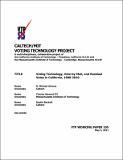| dc.contributor.author | Alvarez, R. Michael | |
| dc.contributor.author | Stewart III, Charles H. | |
| dc.contributor.author | Beckett, Dustin | |
| dc.date.accessioned | 2015-04-16T13:21:31Z | |
| dc.date.available | 2015-04-16T13:21:31Z | |
| dc.date.issued | 2011-05-05 | |
| dc.identifier.uri | http://hdl.handle.net/1721.1/96633 | |
| dc.description.abstract | This paper examines how the growth in vote-by-mail and changes in voting technologies led to changes in the residual vote rate in California from 1990 to 2010. We find that in California’s presidential elections, counties that abandoned punch cards in favor of optical scanning enjoyed a significant improvement in the residual vote rate. However, these findings do not always translate to other races. For instance, find that the InkaVote system in Los Angeles has been a mixed success, performing very well in presidential and gubernatorial races, fairly well for ballot propositions, and poorly in Senate races. We also conduct the first analysis of the effects of the rise of vote-by-mail on residual votes. Regardless of the race, increased use of the mails to cast ballots is robustly associated with a rise in the residual vote rate. The effect is so strong that the rise of voting by mail in California has mostly wiped out all the reductions in residual votes that were due to improved voting technologies since the early 1990s. | en_US |
| dc.language.iso | en_US | en_US |
| dc.publisher | Caltech/MIT Voting Technology Project | en_US |
| dc.relation.ispartofseries | VTP Working Paper Series;105 | |
| dc.title | Voting Technology, Vote-by-Mail, and Residual Votes in California, 1990-2010 | en_US |
| dc.type | Working Paper | en_US |
